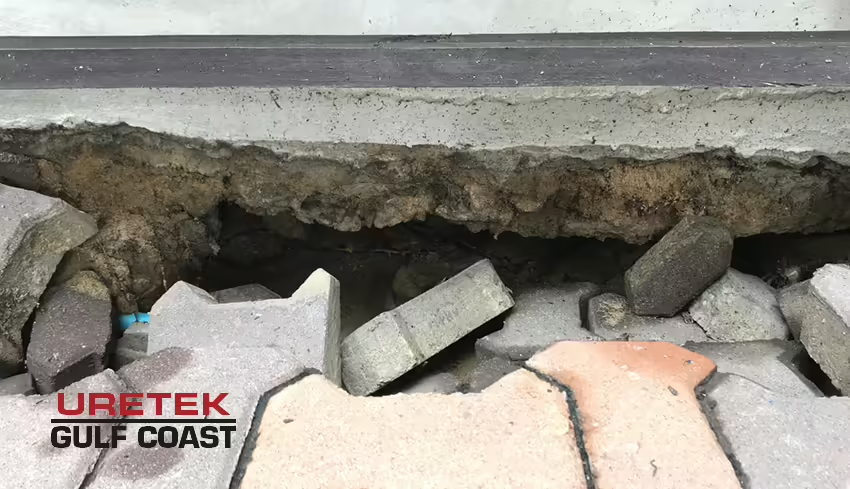If you’re noticing signs that your slab foundation may have an underlying void, there are several next steps that you can take. You may research DIY solutions, investigate nearby foundation experts, or decide to postpone further work.
If you know what happens if you don’t fix foundation problems, you may try to act sooner than later. This article will walk you through some potential causes, and how to fix a void under a concrete slab foundation.
Quick Note on DIY Concrete Void Filling
Foundation repair can sometimes be an expensive, yet unavoidable process. After spotting drywall cracks that keep coming back, gaps between your foundation and wall, or a door frame that’s pulling away from the wall, you may suspect that you’ve got an issue. In your mind, learning some sort of DIY concrete void filling technique could fix all your problems.
At Leveled Concrete, we recommend you trust our experienced foundation repair contractors in Houston with your repairs the first time around. DIY techniques may be suitable for low-risk areas like walkways, but can significantly draw out the process of fixing erosion under your high-risk concrete slab.
So, we urge you to move past your attempt to DIY fill a void under your concrete slab and go with the professionals.
Causes of Voids Under Concrete Slabs
There are two main culprits to voids under a slab foundation, and they both revolve around moisture. In some instances, these causes are unavoidable. However, there are some cases in which you can help prevent these problems from leading to foundation damage.
Erosion from Plumbing Leaks or Poor Water Drainage
If your foundation wasn’t built to drain water away from your slab foundations, there is an increased chance of topsoil erosion that can cause a void under your foundation.
Poor drainage channels and improper foundation sloping can result in a loss of structurally important foundation soil. Many times, this leads to the formation of voids beneath concrete slab foundations.
Faulty under-slab plumbing can also contribute to the formation of voids. Water build-up from leaky pipes underneath building structures will trigger further soil erosion.
Soil Settlement
Cracks in your walls and ceilings can be due to standard house settling but are sometimes symptoms of more serious problems. Major soil settlement can cause voids under concrete slabs. Soil settlement develops slowly and is worsened by the erosive behavior of poorly drained water.
For some drainage tips, see our blog post about ways to prevent soil erosion around your house foundation.
Does a Void Under Your Slab Foundation Need to be Repaired?
Voids underneath concrete slab foundations can lead to settlement. Settlement can cause several symptoms including:
- Buckling walls
- Tilted/leaning walls
- Uneven floors with dips and bowls
- Complete foundation disruption
These signs of foundation issues indicate an urgent need for remediation measures to regain the structural integrity of your building foundation.
How to Fill a Void Under a Concrete Slab
There are three main techniques that professionals use to fill voids under concrete slabs.
Mudjacking
A type of sand-cement slurry (called “mud” in the industry) can be used to fill voids under concrete slabs. This mixture of sand, cement, and water is pumped through holes drilled in a slab foundation to fill voids underneath. While this type of slab jacking can be cost-effective, there are some potential drawbacks to going for this type of repair.
- Void penetration is not always exhaustive, and this can result in future damage.
- The curing time for the filled concrete is extensive (approximately two to three weeks depending on airflow).
- Cementitious slurry is heavy and can be time-consuming to dig through should under slab plumbing repairs on plumbing be needed in the future.
Check out our blog post to learn more about mudjacking vs. polyurethane foam jacking.
Foam Injection
This innovative method of foundation void filling uses polyurethane foam to achieve slab stability. This high-density foam is injected into small holes drilled into your concrete slab. Upon injection, the polyurethane foam chemical reacts causing an expansion to fill and seal void defects.
Polyurethane foam void filling has the following advantages:
- A characteristic specific to Leveled Concrete’s polymer, it is unaffected by the presence of water or highly saturated soil. This can be especially beneficial if voids are holding water.
- Minimal downtime with repaired slabs almost immediately usable after repair.
- Leveled Concrete’s polyurethane foam can consolidate both organic and inorganic material, increasing the stability of the foundation soil.
- Penetrates hard to reach void areas that mud slurry sometimes cannot.
Sectional Slab Repair
Instead of slab jacking, sectional slab repair involves repairing discrete sections of your damaged concrete slab.
After identifying the void under your slab, the concrete over that area can be broken up to provide access to the void. The void is then filled with sand and sealed with a concrete mixture that is level with your slab. Sand filling must be properly compacted so that your under-slab void doesn’t reform.
Contact Leveled Concrete Today for Foundation Void Filling in Houston
Leveled Concrete is dedicated to providing the highest quality Houston foundation repair services. With our unique foam foundation repair technology for filling voids, you can rest assured that we’ll meet and exceed your foundation repair and maintenance needs.
To learn more about our highly effective foundation repair techniques, please contact us online today to schedule a free estimate!

